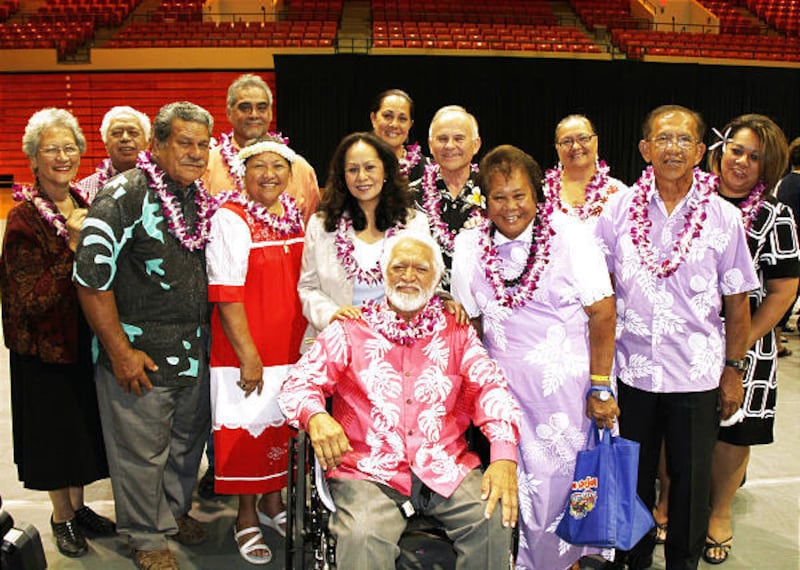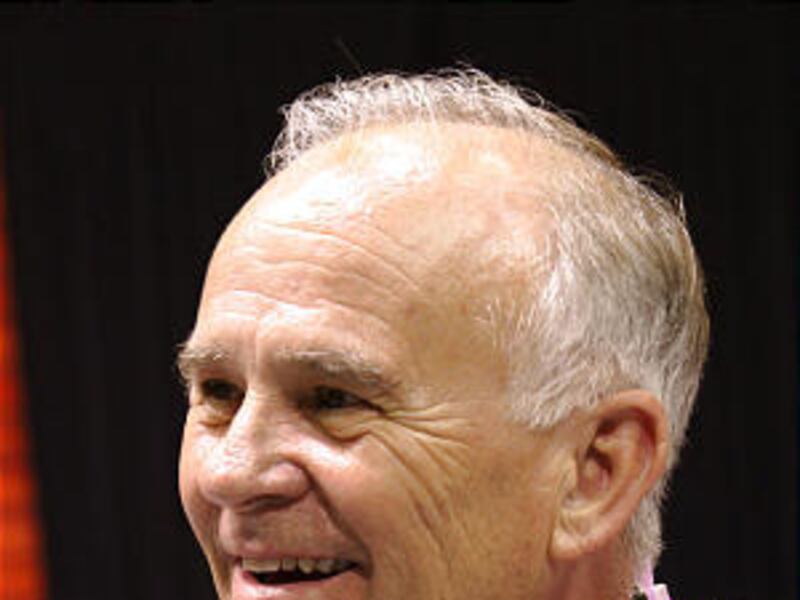LAIE, Hawaii — Cast and crew members of the 1969 Latter-day Saint film "Johnny Lingo" reunited on July 29, 2010, in the BYU–Hawaii Cannon Activities Center to celebrate the cinematic Polynesian fable's perennial popularity over the past 40 years. At the same time, they heard from two of its main characters, Naomi Kaho'ilua Wilson, who acted in the role of Mahana, and Joseph Ah Quin, who played her father, Moki.
The BYU–Hawaii-based Mormon Pacific Historical Society and the Laie Community Association co-sponsored the reunion as part of the annual Laie Days, which, similar to the Days of '47 in Utah, celebrates Laie's Latter-day Saint pioneer heritage going back to 1865.
The 24-minute "Johnny Lingo," filmed on location here by the Brigham Young University Motion Picture Studio for the church's Sunday School auxiliary, tells how a Polynesian trader played by the late Hawaiian actor, Makee Blaisdell (also known as Blaizdel MaKee), gets ridiculed after he offers Moki the excessive bride-price of eight cows for Mahana.The film, which does not mention Mormonism, has proved consistently popular all over the world, as demonstrated by the fact that at least once a year, every year since it was produced, Wilson is asked to speak on her role as Mahana, and fans still recognize the Hawaiian beauty wherever she travels.
After the audience watched the film, Wilson explained that she grew up in the Hawaiian homestead community of Keaukaha near Hilo and since 1975 has lived in Spokane, Wash., where she teaches classical piano to advanced students. When she was a sophomore speech major at Church College of Hawaii (renamed BYU–Hawaii in 1974), studio director Wetzel O. "Judge" Whitaker picked her to play Mahana.
Once filming began, Wilson recalled that Whitaker was worried about a scene where she was hiding up in a tree, but nobody had brought a ladder, so she simply used her Hawaiian childhood skills to climb a vine attached to the tree. "By the time I got to the top, I so became Mahana," she said, adding it was also hard for her to keep a straight face when she peeked down because the wigs Moki and his elderly adviser — played by the late Joe Te Ngaio, a Maori who worked at the Polynesian Cultural Center — looked so funny.
Wilson also admitted that "the real potential and worth of the film was invisible to me at the time. I was unaware of what the Lord was trying to make of us"; but Mahana's character soon began playing a positive role in her life.She noted the film has also become an influence for good. For example, an Air Force officer she met on a plane told her the Pentagon showed "Johnny Lingo" in various countries "that had experienced disasters. It helped the people to rebuild."
And a church member from Ghana then serving a mission in Nigeria wrote about 10 years ago to tell Wilson that as he watched the movie, "I had a wonderful feeling that my life would be better if I continued to try, that my Heavenly Father knew my heart and would help me to become the man that I should."
Wilson added she receives a bag of similar letters from church headquarters every few years.
"The journey of Mahana has taught me many things," she said. "I have learned to measure success by doing the most good for as many people as possible with that which the Lord has entrusted us."
The Laie-born Ah Quin, a white-bearded Hawaiian who is best known for his beautiful singing voice and willingness to share it, came directly to the reunion from being hospitalized for a broken ankle. He explained he got reacquainted with Wilson about 25 years ago when she invited him to sing "The Lord's Prayer" at her son's missionary farewell in Spokane, and added that he hoped he has used his talents "to be a good representative of the gospel. My love goes out to each and every one of you."
Ann Terry of Honopou, Maui, came to the reunion to represent her brother, Blaisdell, who passed away in 1988. She explained that Makee "was always an actor," and that he also worked on stage and in television productions. "He was a Shakespearean actor — so dramatic. You could probably see that when he was acting in the film," she said.
After the reunion, producer David Jacobs explained how "Johnny Lingo" came to be filmed in Laie: Though the original story written by Patricia McGerr was set "in the Pacific," Whitaker and his brother, Scott, who was a screenwriter, wanted to film in California for budgetary reasons. However, Jacobs, who previously worked at the studio and had taught speech here in 1967-68, suggested that the Church College of Hawaii and the adjacent Polynesian Cultural Center would be the perfect base of operations.
"I prayed about it a lot, and I knew it had to be here," said Jacobs, who is now retired from the Motion Picture Studio and lives in Orem. "We could stay in the dormitories … and the students could help us … with the ocean, mountains and waterfalls within minutes. CCH was the answer … and they were so willing to help.
"The cast and crew started each day with prayer, and we really took this film seriously," he continued. Still, that didn't mean there weren't hurdles. For example, Jacobs responded to Wilson's comments about the wigs for Moki and his adviser. He ended up buying the wigs at Ala Moana Shopping Center in Honolulu. "They were awful from the day we saw them, but Judge said we just had to have them.
"This film is amazing. It just keeps going and giving," Jacobs said. "We knew we were making this film for the whole church, but little did we know this was going to reach the whole world."
Other "Johnny Lingo" cast and crew members at the reunion included Bill Ah Quin, a production crew member now living in Utah; Tuione Pulotu, who did the set design and construction; Kent Fonoimoana, the village boy who first sees Johnny Lingo at the beginning of the film, and his sisters Maria Feagai and Cindy Tutor, who played village children; Mahana Pulotu, who loaned her name to the female lead; and William and Emma Ernestburg, who played villagers with their children Gilberta, McKay and Pumpkin Ernestburg.




